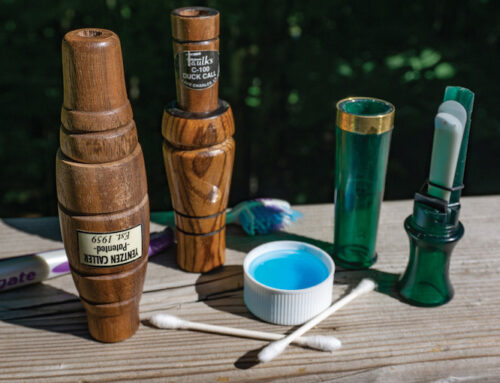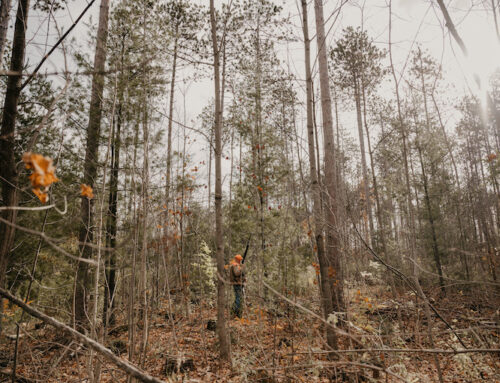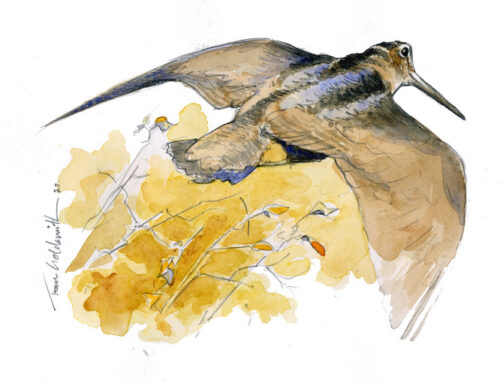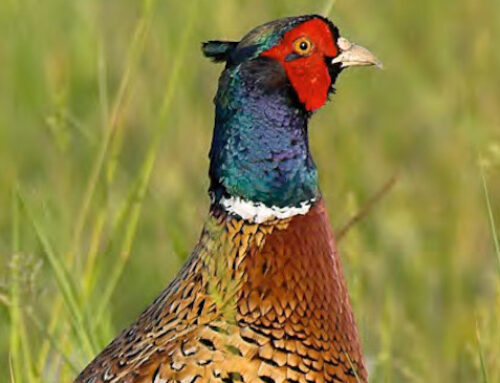Norfolk County is dotted with tobacco kilns, ginseng gardens, woodlots, century homes, roadside markets, and pretty little towns. It’s contained by big skies and fragrant cedar windrows. The people here are rooted in the land; stewardship is important, and simple country traditions still count for something. Norfolk County is what much of rural Ontario used to be.
These days there’s good news there too. At least it’s good if you’re a hunter. For in Norfolk County, as well as in much of Ontario’s south and west, jackrabbits are back.
I arrived at the Scheers farm near Delhi at 7:30 a.m. Overnight, a fierce winter storm had swept in from the west. Snow swirled across the flats and drifts leaned high against the bone-white tobacco kilns and cedars. But, as I parked, a deep-blue sky was being unfurled by the rising sun. You couldn’t ask for a nicer February morning.
By 8 a.m. a dozen hunters had gathered for coffee and doughnuts inside the empty tobacco-stripping barn. The scene, I imagine, couldn’t have been much different from those of 40 years ago when jack rabbit drives were a rite of passage for adult hunters and farm boys of southern Ontario. There was laughter, farm talk, and news from surrounding communities. The morning’s manoeuvres were planned and old friendships renewed. There was the aura of a good deer camp. And there was eagerness too, for 2004 was a great year for jacks.
John Ryder of Delhi is a farmer. Like many other locals his age, he grew up hunting jacks, more correctly known as European hares, in the big concession-to-concession drives of days gone by. He’s been chasing them, on and off, for about 50 years. He and others in the gang remember the mid-1960s as the heyday of the hare in the southwest. Then, jacks were sometimes seen in the sandy tobacco-growing soil around Delhi, but they were more common in the clay belt to the southwest. Ryder said, “There were more fencerows there and the crops were better suited to rabbits.”
The older hunters observe that hare populations crashed somewhere around 1970. Some biologists, such as Pud Hunter of the Ministry of Natural Resources(MNR)Aylmer District Office, suggest that DDT and other pesticides contributed to this. But Allan Boraski of Wilsonville, also an avid rabbit hunter, believes other factors brought this about.
“Mostly, I think it was predators and changing land-use practices,” he said. “We shot our first coyote here in 1966. The decline of the jacks coincided with increased coyote and fox numbers.” About the same time, he adds, more efficient farms gobbled up edge cover that jacks needed to avoid predators.
Whatever the reasons, by the early 1980s most hunters had given up on them and by the 1990s these sporty hares were largely relegated to stories of the good old days. Even the popular Boxing Day drives were replaced by trap shoots.
The pendulum swung back in the mid-1990s. That’s when Ryder began noticing the jacks again. “They were eating tobacco, something they never used to do. Even waterlines were not safe…I’d tell people that we had a jack rabbit problem and they’d laugh. But within two or three years people were noticing.”
Ryder believes that, once again, changing land use and predator populations were responsible. “People were planting hedgerows and building ponds. Some switched from growing tobacco to cash crops or orchards. There were better farming practices too. And mange knocked back our coyotes and foxes. All this was favourable to the jack rabbit. Around here, they came back with a vengeance.”
For Ryder and his neighbours, the old days had returned. He began organizing hunts again, often responding to requests from neighbouring farmers who considered jacks to be a pest. Since then, Ryder’s gang and others have had no shortage of hunting opportunities.
This is why I was in that tobacco-stripping barn on that day. Steve Scheers of Delhi provided the gracious invitation. Aside from being a competent sportsman, Scheers is also Norfolk County’s superintendent of the Forestry and Cemeteries Division. I made his acquaintance while researching a story on pheasant hunting in Ontario. He happened to be the go-to guy in Norfolk. Some time during the interview he said, “We’ve got very good pheasant-hunting opportunities here, but our jack rabbit hunt is excellent.” Suddenly, he had my undivided attention.
After breakfast we drove to another farm, where John Ryder divided us into drivers and blockers. Even as he did, we watched a jack run across a distant field in a way that somehow reminded you of a gazelle on the African plain. The morning’s first hunt would sweep through that, and adjacent fields, from the far side of the concession, back to the barnyard.
Jason Ryder, John’s 28-year-old son, positioned me along a cedar windrow. To my left and right, a line of blockers formed, each covering one side of a hedgerow and the fields between.
The others got in trucks and drove snow-covered roads to the next concession line, approximately one mile away. There, they began walking hedgerows, one hunter on each side, towards us. After a few minutes, you could see blaze-orange specks in the distance. And, as they got nearer, sometimes you could see hares flush just ahead.
Some broke from the hedgerows, others leapt from their forms in furrowed fields, where they lay half-covered in snow, facing into the wind. For the most part they moved in little bounds, stopping after a bit to look around, but when they moved flat out, that was something.
Stewart Hazen of Delhi shot the first hare as it loped by him in the middle of an open field. A 3-inch load of BBs, fired from his 12-gauge, did the job admirably.
One thing you notice almost immediately is that there are no experts on a jack hunt. There are good gunners and experienced men, yes, and also younger hunters with more stamina and perhaps different ideas, but, all in all, the jacks seem to keep everyone honest and humble. One hunter is as likely to shoot as the next. The old ways seem as likely as the new. As hunting goes, this is about as democratic as it comes.
Rick Szabo of Waterford said, “It’s a great winter hunting activity.” He’s right; the hunting is best when almost every other hunt is closed. When the drivers met the blockers, we got into trucks and drove to the next area.
Three other drives were conducted that morning. Each covered between 200 and 300 acres of farmland. Of the old days, Boraski said, “The drivers would sometimes form an inverted V. The wingers tended to drive hares into the centre of the hunt.” Other than that, tactics remain relatively simple.
Most hunters use a 12-gauge pump or auto, with modified or full choke, capable of firing 3-inch shells or better. Lead BBs and 2s are preferred. Long running shots are common and often difficult, especially since these hares can attain speeds of 30 miles per hour and leap 12 feet at a bound.
Ryder says to treat them like you would a deer. “Stay still as they approach and try to get them before they’re moving flat out.”
By noon the gang had taken six hares. It turned out to be their worst hunt of the season, a testament to how good the season was.
We regrouped at the Scheers farm, grateful for the venison chili, pickles, coffee, doughnuts, and other fine country fare. This time, the hunters were red-faced from the cold, but somehow the smiles and laughter seemed warmer. Another hunt had brought them together. More fine memories were forged.
Rick Szabo summed it up. “I enjoy seeing the jacks again,” he said. “Even if you don’t get any, it’s just nice to live in a place where you can see them and hunt like this. It’s just good to get out with the boys.”
Yes, the jacks are back. Let’s hope they stay awhile.







Hi Steve
What a great post, you brought me back in the 70s, I thought I was there till my wife yelled that dinner was ready and I snapped from my back in the day dream.
Fantastic, keep up the great writing.
The one main factor that I’ve realized with the jackrabbits in Southern Ontario a lot of changes in the agricultural side from the coyotes pressure and the pressure from The hunting. I have sent an email to the MNR reguards about my concern with the jackrabbit population being far and few why not have the regulations changed as in the bag limit and daily possession. we need to create a better regulation to enforce population of the jackrabbit before Extinction but nobody seems to take any action or care about this species in particular when you’re still allowed to hunt in groups of 10 to 20 guys using dogs with GPS tracking devices using rifles I seen guys with 22 magnum and 223 I think he’s kind of rifle should be restricted for use for jackrabbits and reduce the size of group of hunters to maximum five and a limit of jackrabbits for group of two. Which is far and few still to come across we need to create a petition in order to start this movement if we are interested in having this Jackrabbit population come back in some areas where there still exist it be nice someone that has the authority and power that can speak for us on our behalf to change the hunting regulations for Hare JACK RABBIT.
Perfect weather ,a foot of snow . My old trick for locating Jacks . First I drive from fence line to fence line . Break out my bronulars and look for dug in rabbits snoozing after a night of running snowmobile trials and side roads. They dig in to snow banks for warmth. So I look for a black tipped set of raidars sticking straight up. On locating them I slowly sneek up 25 to 30 ft out from if you can get in line with them with out them bursting like a race horse from the gate try to get the in the head to preserve the be meat . If they bust you early I usually lead them by 2 to 3 ft and 8 out of 10 times results in head shot. ( IT WORKS FOR Me!)
I really enjoy hunting jacks.there are plenty in the chatham kent area
MNR doesn’t care about Jacks. They are an invasive species! The good old days of jack hunting are pretty much done. There are a few pockets of hares around, but not enough to keep this hunt around. Last year I saw four separate tracks driving from side road to sideroad. Pretty sad!
Habitat is the problem , there isn’t any left for them to have a chance . I hunt jacks from the first inch of snow till season end and i don’t see 10 – 20 hunters hunting them the hunting pressure in non existent so it’s ridiculous to go there. As for the limit your not getting a limit of jacks now a days. So there really no point in changing the bag limit. Too much effort to try and bag a jack for most. Die hards are successful in bagging a few in a season but most would rather sit in a tree or walk or ride a trail to bag a grouse. All I hear is there’s less game out there which-is true but there huntable numbers of all game species. Just more effort is needed to be successful.